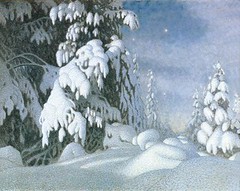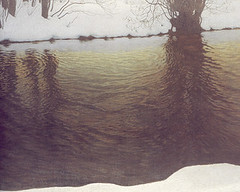When I got home, I googled Mr Fjaestad, to find this passage about him on the Art Fund website:
Gustav Fjaestad (1868-1948), made the frost- covered fields and snow-laden branches of the Swedish winter his hallmark. He too adopted country life, migrating to the densely forested province of Varmland in western Sweden, where he and his wife became the centre of a group of artists and craftsmen. But he was less interested in depicting country activities or wildlife than in exploiting the abstract pictorial qualities of the landscape. In his hands, the countryside in its winter guise became a vehicle for decorative surface patterns of dots and swirling Art Nouveau inspired arabesques. Yet they are never blandly pretty, and occasionally contain a hint of menace. The cold, unknown depths of the mysterious stretch of water contained within snowy river banks in Winter Evening by a River carry a sense of foreboding. Art Fund Magazine (author not credited)
To me there was no menace about the pictures - this was one of their key delights, that they felt entirely calm. (Perhaps this is one of the most interesting things about art, or the arts in general: the much room left for individual interpretation, the diversity of response and the unknown intentions of the creator.) To me the pictures spoke of perfect, untouched beauty. They reminded me of a visit to Esthwaite Water in the English Lake District, at twilight, when there was a light breeze rippling the lake like silk and the silver birches hung their heads ponderously over the water. The whole atmosphere was scented with the calm of evening, and I lay down on the quay to watch the fishing boats bob on the water and felt completely at peace. Probably if I did this on a day like the ones in Fjaestad's paintings, I'd freeze to the dock and would have to be cut out, planks still frozen to my back, but then nothing is quite how it looks in the picture...
Pictures from: www.mundofree.com, www.teosofiskakompaniet.net



3 comments:
Never heard of him before, but paintings are very beautiful - just like Livby
you wouldn't happen to know the names of these paintings, would you?
"Vinter Månsken (Winter Moonlight)"
was painted in 1895 while on a skiing trip in the province of Värmland, where Fjaestad eventually built a home on lake Racken. There he could observe the icy, just melted, streams' flow. He began to paint the running water theme in 1901 as tapestry cartoons and oil paintings. There are several examples of this motif as he continued to paint it throughout his life. You can see the tapestries at the National Art museum in Copenhagen and in Gothenburg at the Rhoska Museum
and the painting can be seen at the Thiel Gallery in Stockholm. The most sensational is perhaps the tapestry cartoon which is in Arvika at the Rackstad Museua. These are popular works for exhibitions so telephone first before traveling to see them.
You may contact me for further information. fjaestadsart@swipnet.se
Post a Comment